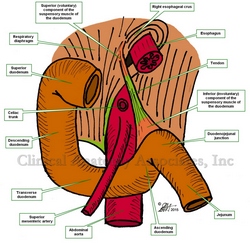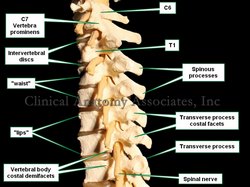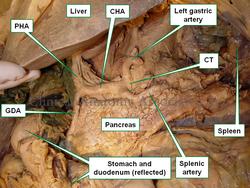
Medical Terminology Daily (MTD) is a blog sponsored by Clinical Anatomy Associates, Inc. as a service to the medical community. We post anatomical, medical or surgical terms, their meaning and usage, as well as biographical notes on anatomists, surgeons, and researchers through the ages. Be warned that some of the images used depict human anatomical specimens.
You are welcome to submit questions and suggestions using our "Contact Us" form. The information on this blog follows the terms on our "Privacy and Security Statement" and cannot be construed as medical guidance or instructions for treatment.
We have 648 guests online

Jean George Bachmann
(1877 – 1959)
French physician–physiologist whose experimental work in the early twentieth century provided the first clear functional description of a preferential interatrial conduction pathway. This structure, eponymically named “Bachmann’s bundle”, plays a central role in normal atrial activation and in the pathophysiology of interatrial block and atrial arrhythmias.
As a young man, Bachmann served as a merchant sailor, crossing the Atlantic multiple times. He emigrated to the United States in 1902 and earned his medical degree at the top of his class from Jefferson Medical College in Philadelphia in 1907. He stayed at this Medical College as a demonstrator and physiologist. In 1910, he joined Emory University in Atlanta. Between 1917 -1918 he served as a medical officer in the US Army. He retired from Emory in 1947 and continued his private medical practice until his death in 1959.
On the personal side, Bachmann was a man of many talents: a polyglot, he was fluent in German, French, Spanish and English. He was a chef in his own right and occasionally worked as a chef in international hotels. In fact, he paid his tuition at Jefferson Medical College, working both as a chef and as a language tutor.
The intrinsic cardiac conduction system was a major focus of cardiovascular research in the late nineteenth and early twentieth centuries. The atrioventricular (AV) node was discovered and described by Sunao Tawara and Karl Albert Aschoff in 1906, and the sinoatrial node by Arthur Keith and Martin Flack in 1907.
While the connections that distribute the electrical impulse from the AV node to the ventricles were known through the works of Wilhelm His Jr, in 1893 and Jan Evangelista Purkinje in 1839, the mechanism by which electrical impulses spread between the atria remained uncertain.
In 1916 Bachmann published a paper titled “The Inter-Auricular Time Interval” in the American Journal of Physiology. Bachmann measured activation times between the right and left atria and demonstrated that interruption of a distinct anterior interatrial muscular band resulted in delayed left atrial activation. He concluded that this band constituted the principal route for rapid interatrial conduction.
Subsequent anatomical and electrophysiological studies confirmed the importance of the structure described by Bachmann, which came to bear his name. Bachmann’s bundle is now recognized as a key determinant of atrial activation patterns, and its dysfunction is associated with interatrial block, atrial fibrillation, and abnormal P-wave morphology. His work remains foundational in both basic cardiac anatomy and clinical electrophysiology.
Sources and references
1. Bachmann G. “The inter-auricular time interval”. Am J Physiol. 1916;41:309–320.
2. Hurst JW. “Profiles in Cardiology: Jean George Bachmann (1877–1959)”. Clin Cardiol. 1987;10:185–187.
3. Lemery R, Guiraudon G, Veinot JP. “Anatomic description of Bachmann’s bundle and its relation to the atrial septum”. Am J Cardiol. 2003;91:148–152.
4. "Remembering the canonical discoverers of the core components of the mammalian cardiac conduction system: Keith and Flack, Aschoff and Tawara, His, and Purkinje" Icilio Cavero and Henry Holzgrefe Advances in Physiology Education 2022 46:4, 549-579.
5. Knol WG, de Vos CB, Crijns HJGM, et al. “The Bachmann bundle and interatrial conduction” Heart Rhythm. 2019;16:127–133.
6. “Iatrogenic biatrial flutter. The role of the Bachmann’s bundle” Constán E.; García F., Linde, A.. Complejo Hospitalario de Jaén, Jaén. Spain
7. Keith A, Flack M. The form and nature of the muscular connections between the primary divisions of the vertebrate heart. J Anat Physiol 41: 172–189, 1907.
"Clinical Anatomy Associates, Inc., and the contributors of "Medical Terminology Daily" wish to thank all individuals who donate their bodies and tissues for the advancement of education and research”.
Click here for more information
- Details
There are two types of [costal facets]: costal demifacets, and transverse costal facets.
The first type are small, half-moon shaped facets found in the posterior aspect of the vertebral body of thoracicvertebrae. They are called demifacets, from the French word [demi], which itself derives from the Latin [dimidius] meaning "split in two" or "halved". A demifacet is "half a small face". There is usually one larger superior demifacet and a smaller inferior demifacet, both close to the area where the vertebral body meets the pedicle. Anothe term for each demifacet is a fovea costalis. The articulation of two adjacent demifacets and one rib form a costovertebral joint.
The second type are articular facets found in the transverse processes of the thoracic vertebrae. These allow most of the rib to articulate with the same number vertebra (T1 - Rib 1, T2 - Rib 2, etc). The articulation of a transverse costal facet and one rib form a costotransverse joint.
There are specific variations to these facets and joints as follows:
• T11 and T12 do not have transverse costal facets
• T1 has a complete superior costal facet for rib #1 and an inferior demifacet for rib #2
• T11 and T12 have a complete costal facet on their vertebral body, no demifacets
Image property of: CAA.Inc. Photographer: David M. Klein
- Details
This medical term is formed by the prefix [intra-] meaning “within”, or "inside", the root term [-periton-] meaning “peritoneum”, and the adjectival suffix [-eal], meaning “pertaining to”. In the strictest sense, the term [intraperitoneal] means “inside the peritoneum”.
The term is used to refer to anatomical structures that are contained inside the peritoneum, or inside the peritoneal sac. Now, this is a misconception, as all the so-called "intraperitoneal" structures are actually outside the peritoneum. This is better explained by looking at the accompanying image. The peritoneum drapes around the abdominal organs giving these organs an external layer called a serosa. This also forms double-layered extensions called a mesentery, a meso, an omentum, or a ligament.
The fact that these "intraperitoneal" structures have this double-layered peritoneal extension renders them mobile. They can, within reason, move around with peristalsis and gravity.
- Details
In my years of experience as a medical industry trainer, and specially in the cardiovascular arena, I doubt if I ever received the correct answer to the question "How many are the great vessels?". Answer it now before you read the rest of this article, you may be surprised!
A great vessel is an artery or a vein that is in direct contact with the heart taking or bringing blood from the heart to the body and vice versa. At this point, most of the attendees to one of my conferences would answer "4". This is not correct.
The great vessels are:
• Aorta
• Pulmonary trunk
• Superior vena cava
• inferior vena cava
• Pulmonary veins
There are four pulmonary veins, two on each side (sometimes three on the right side), one superior and one inferior. This brings the total number of the great vessels to eight! By the way, if you answered "pulmonary artery" as one of the great vessels, that is not correct. Read more on the correct answer here.
Human heart clinical anatomy and pathology are some of the many lecture topics developed and presented by Clinical Anatomy Associates, Inc.
Sources:
1. "Tratado de Anatomia Humana" Testut et Latarjet 8 Ed. 1931 Salvat Editores, Spain
2. "Gray's Anatomy" 38th British Ed. Churchill Livingstone 1995
- Details

Click on the image for a larger version
The duodenojejunal junction is the point where the fourth segment of the duodenum, the ascending duodenum, meets and is continuous with the most proximal portion of the jejunum.
The suspensory muscle of the duodenum attaches to the superior aspect of the duodenojejunal junction. This muscle is also known as the "muscle of Treitz" or "musculus suspensorius duodenii" and was first described in 1853 by Dr. Václav Treitz. The parietal peritoneum forms a fold over the suspensory muscle of the duodenum and this fold is known as the "ligament of Treitz".
The duodenojejunal junction (marked by the ligament of Treitz) is an important anatomical landmark used by anatomists and surgeons to denote the point where the small intestine passes from retroperitoneal duodenum to intraperitoneal jenunum. This means that while most of the duodenum is covered by parietal peritoneum, plastered to the posterior abdominal wall, and immobilized by it; the jejunum is mobile, meaning that the anatomist and surgeon can easily move it around because of the presence of a well-developed mesentery.
Sources:
1. "Clinically Oriented Anatomy" Moore, KL. 3r Ed. Williams & Wilkins 1992
2. "The origin of Medical Terms" Skinner, AH, 1970
3. "The suspensory muscle of the duodenum and its nerve supply" Jit, I.; Singh, S. J. Anat. (1977), 123, 2, pp. 397-405
4. "Anatomical and functional aspects of the human suspensory muscle of the duodenum." Costacurta, L. Acta Anat (Basel). 1972;82(1):34-46
Image property of: CAA.Inc. Artists: Dr. E. Miranda and D.M. Klein
- Details
This word arises from the Latin word [canna], meaning “reed” with the Latin suffix [-ula], used to denote something small. Since reeds are hollow, the word [cannula] can be translated as a “small, hollow reed”.
In medicine, a cannula is a small, hollow tube used to draw fluids or introduce drugs or fluids into the body. It can also be an instrument that is used as a guide for other instruments to be introduced in the body.
Cannulation is the act of using or placing a cannula. The Latin plural for cannula is [cannulae], although the English version [cannulas] is acceptable.
- Details
The [celiac trunk] is the first anterior unpaired branch of the abdominal aorta. Through its branches the celiac trunk provides arterial blood supply to the stomach, spleen, duodenum, and pancreas, as well as the liver. The celiac trunk is related on its left side to the suspensory muscle of the duodenum, which when covered by peritoneum forms the ligament of Treitz.
The celiac trunk is a very short artery which rapidly divides in its three branches:
- Left gastric artery: Provides blood supply to the stomach and is part of the lesser curvature vascular arcade.
- Splenic artery: Provides blood supply to the spleen, and to the stomach through a branch, the left gastroepiploic artery.
- Common hepatic artery: Provides blood supply to the liver, stomach and pancreas
Image property of: CAA.Inc. Photographer: David M. Klein





